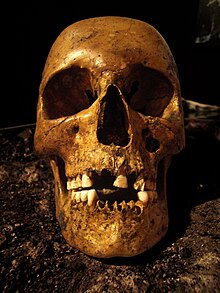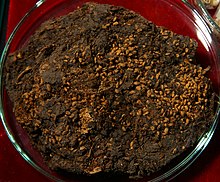May 20 is the 140th day of the year in the Gregorian calendar; 225 days remain until the end of the year.

A bog body is a human cadaver that has been naturally mummified in a peat bog. Such bodies, sometimes known as bog people, are both geographically and chronologically widespread, having been dated to between 8000 BCE and the Second World War. The unifying factor of the bog bodies is that they have been found in peat and are partially preserved; however, the actual levels of preservation vary widely from perfectly preserved to mere skeletons.
Old Europe is a term coined by the Lithuanian archaeologist Marija Gimbutas to describe what she perceived as a relatively homogeneous pre-Indo-European Neolithic and Copper Age culture or civilisation in Southeast Europe, centred in the Lower Danube Valley. Old Europe is also referred to in some literature as the Danube civilisation.

Falköping is a locality and the seat of Falköping Municipality in Västra Götaland County, Sweden. It had 16,350 inhabitants in 2010.
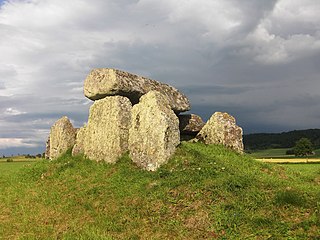
Falbygden is a geographical area, centered at the town of Falköping in Västergötland, in southwestern Sweden, and covered mostly by farmland. Most of the area belongs to Falköping Municipality and the west part of Tidaholm Municipality. In medieval times the area belonged to the hundreds Frökind, Gudhem, Vartofta, and Vilske. It is known for its geology, flora and megalithic culture.
Below are notable events in archaeology that occurred in 1943.
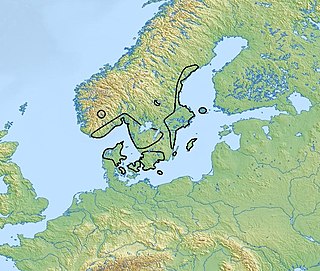
The Pitted Ware culture was a hunter-gatherer culture in southern Scandinavia, mainly along the coasts of Svealand, Götaland, Åland, north-eastern Denmark and southern Norway. Despite its Mesolithic economy, it is by convention classed as Neolithic, since it falls within the period in which farming reached Scandinavia. The Pitted Ware people were largely maritime hunters, and were engaged in lively trade with both the agricultural communities of the Scandinavian interior and other hunter-gatherers of the Baltic Sea.
The archaeology of Northern Europe studies the prehistory of Scandinavia and the adjacent North European Plain, roughly corresponding to the territories of modern Sweden, Norway, Denmark, northern Germany, Poland and the Netherlands.

The prehistory of Ireland has been pieced together from archaeological evidence, which has grown at an increasing rate over the last decades. It begins with the first evidence of permanent human residence in Ireland around 10,500 BC and finishes with the start of the historical record around 400 AD. Both the beginning and end dates of the period are later than for much of Europe and all of the Near East. The prehistoric period covers the Palaeolithic, Mesolithic, Neolithic, Bronze Age and Iron Age societies of Ireland. For much of Europe, the historical record begins when the Romans invaded; as Ireland was not invaded by the Romans its historical record starts later, with the coming of Christianity.

The Lovers of Valdaro, or Valdaro Lovers, are a pair of human skeletons dated as approximately 6,000 years old. They were discovered by archaeologists at a Neolithic tomb in San Giorgio near Mantua, Italy, in 2007. The two individuals were buried face to face with their arms around each other, in a position reminiscent of a "lovers' embrace".

Evidence of human activity during the Mesolithic period in Irish history has been found in excavations at the Mount Sandel Mesolithic site in the north of the island, cremations on the banks of the River Shannon in the west, campsites at Lough Boora in the midlands, and middens and other sites elsewhere in the country..
Fanny Lucille Ketter is a Swedish actress. She is daughter to visual artist and musician Clay Ketter and Jenny Mark Ketter, communications officer at IM, a Swedish N.G.O.
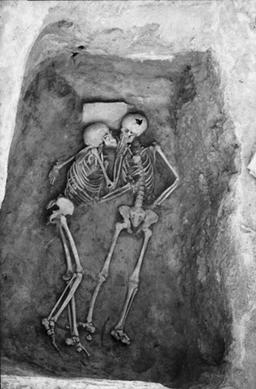
The Hasanlu Lovers are a pair of human remains found at the Teppe Hasanlu archaeological site, located in the Naqadeh in the West Azerbaijan Province of Iran. Around 800 BCE, the city of Hasanlu, located in north-western Iran, was destroyed by an unknown invader. Inhabitants were slain and left where they fell. In 1973, the lovers were discovered by a team of archaeologists from the University of Pennsylvania led by Robert H. Dyson.

The Birka female Viking warrior was a woman buried with the accoutrements of an elite professional Viking warrior in a 10th century chamber-grave in Birka, Sweden. Although the remains were thought to be of a male warrior since the grave's excavation in 1878, both osteological analysis and a 2017 DNA study proved that the remains were of a female: "This was significant because the grave, which was excavated in 1878, had long been seen, and repeatedly published, as a spectacular example of a high-status warrior burial—an identity with intriguing implications in the light of our new sex determination."
Penny Bickle is Senior Lecturer in Archaeology at the University of York and her research focuses on daily routine in the Neolithic period.
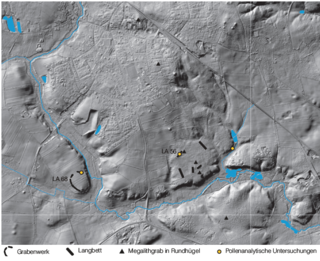
The site Albersdorf-Dieksknöll LA 68 is a causewayed enclosure of the fourth millennium BC in Albersdorf, district Dithmarschen, northern Germany. It is one of the three or four known enclosure sites in Schleswig-Holstein and of the 47 known causewayed enclosure of the Funnel Beaker Culture.
Bengt Alfred Öste was a Swedish journalist and television host. He was the news anchor of Rapport in Sveriges Television (SVT) for 14 years, from 1978 to 1992. Before that, he was news chief from 1972. Öste was also a devoted fisherman and wrote both books and articles on the subject.
Carl-Herman Hjortsjö, born Carl-Herman Hirschlaff, was a Swedish anatomist, physician and physical anthropologist. He was born in Malmö, Sweden, as the son of practicing physician Herold Hirschlaff and Ester, née Sandstedt.
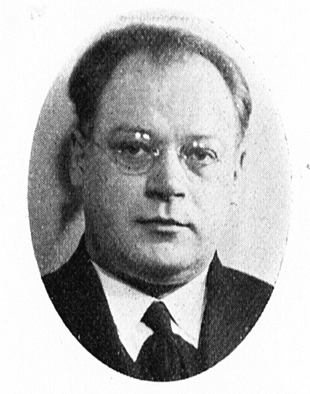
Axel Ivar Bagge was a Swedish archaeologist, who made numerous contributions to the research of the Stone Age remains in Scandinavia.
